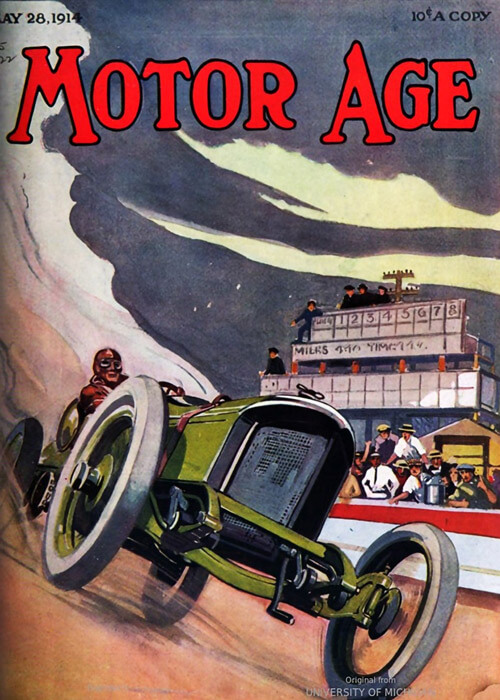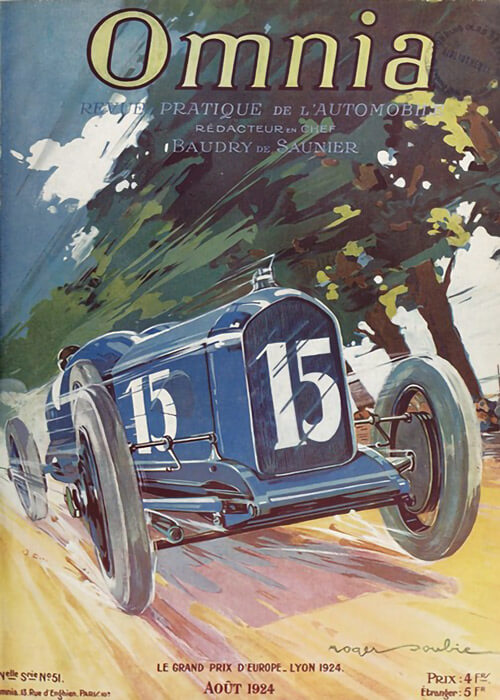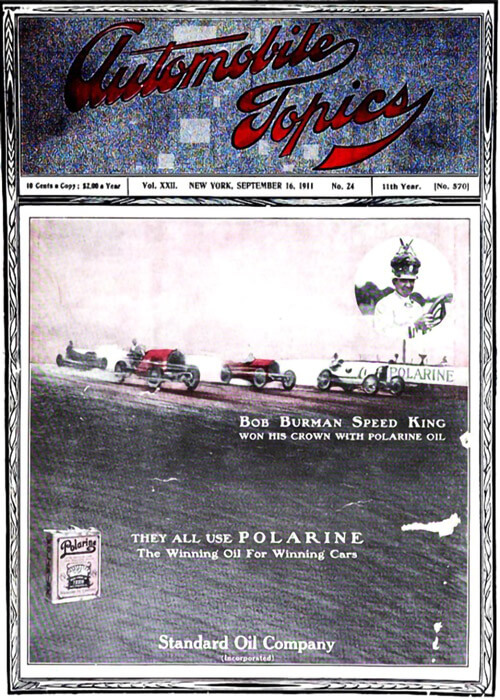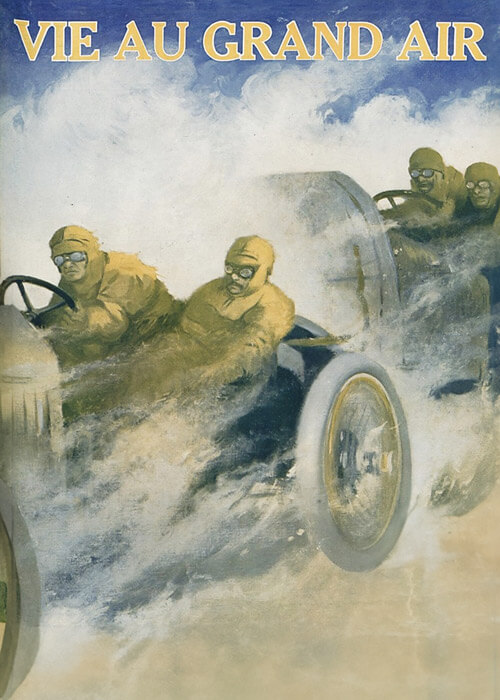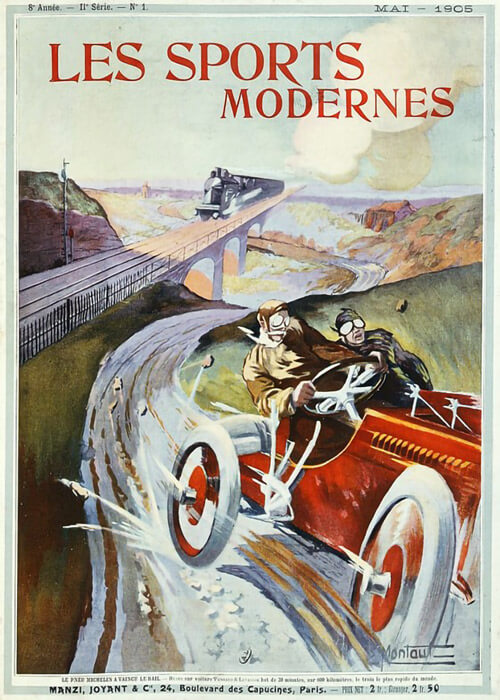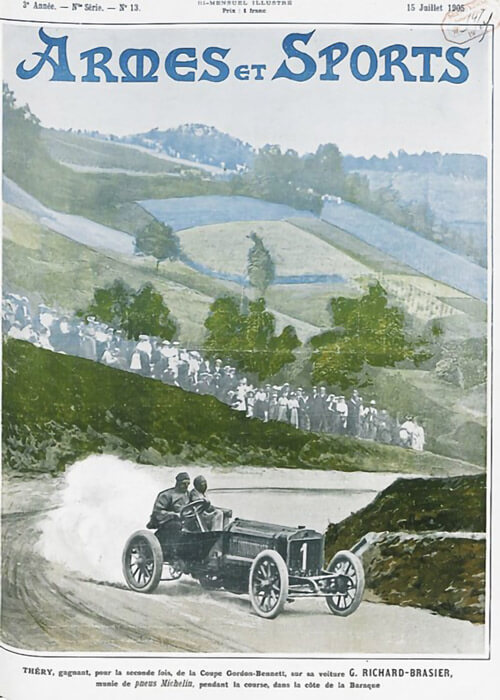
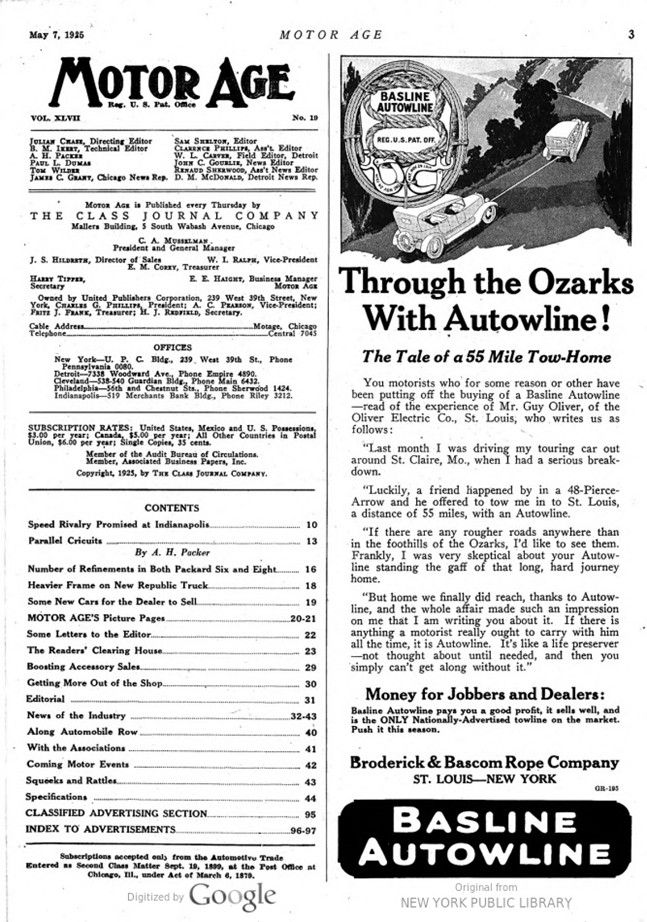
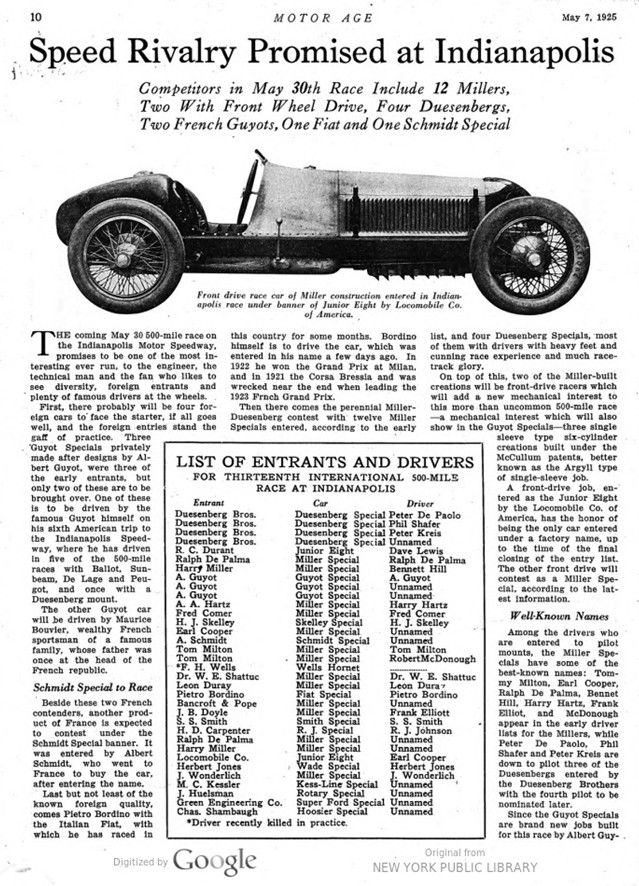




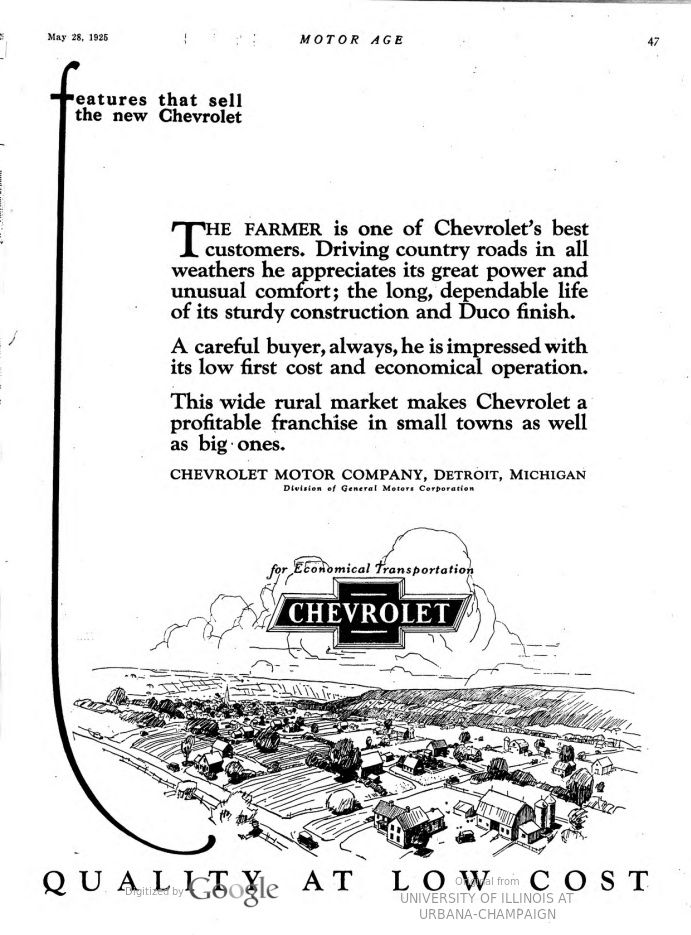


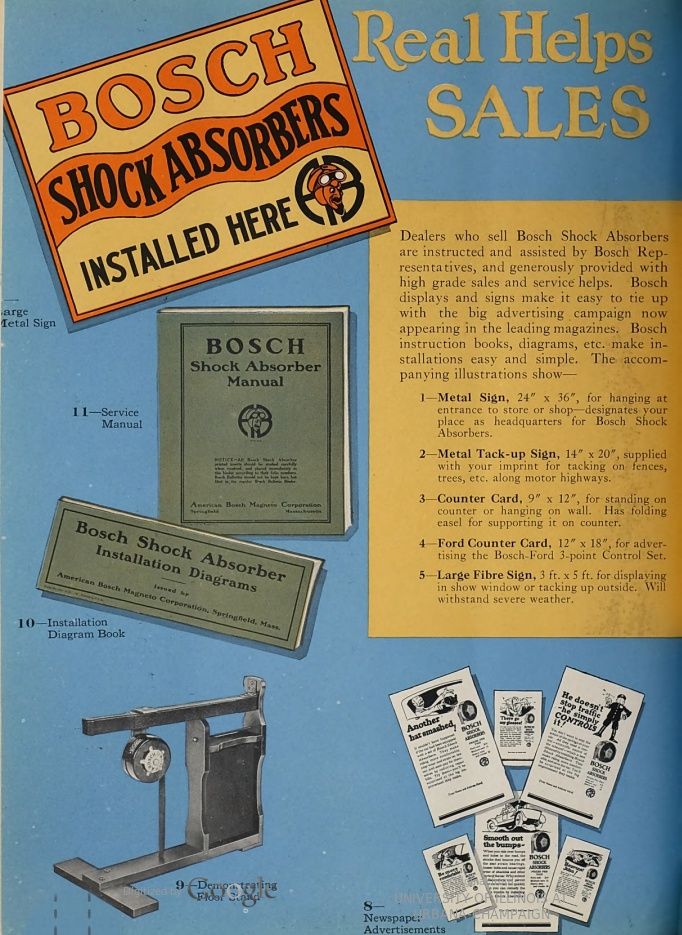
Text and jpegs by courtesy of hathitrust.org www.hathitrust.org, compiled by motorracinghistory.com
Motor Age, Vol. 47, No.19, May 7, 1925
Speed Rivalry Promised at Indianapolis
Competitors in May 30th Race Include 12 Millers, Two With Front Wheel Drive, Four Duesenbergs, Two French Guyots, One Fiat and One Schmidt Special
THE coming May 30 500-mile race on the Indianapolis Motor Speedway, promises to be one of the most in- teresting ever run, to the engineer, the technical man and the fan who likes to see diversity, foreign entrants and plenty of famous drivers at the wheels.
First, there probably will be four for- eign cars to face the starter, if all goes well, and the foreign entries stand the gaff of practice. Three ‚Guyot Specials privately made after designs by Al- bert Guyot, were three of the early entrants, but only two of these are to be brought over. One of these is to be driven by the famous Guyot himself on his sixth American trip to the Indianapolis Speedway, where he has driven in five of the 500-mile races with Ballot, Sunbeam, De Lage and Peugeot and once with Duesenberg mount.
The other Guyot car will be driven by Maurice Bouvier, wealthy French sportsman of a famous family, whose father was once at the head of the French republic.
Schmidt Special to Race
Beside these two French contenders, another product of France is expected to contest under the Schmidt Special banner. It was entered by Albert Schmidt, who went to France to buy the car, after entering the name.
Last but not least of the known foreign quality, comes Pietro Bordino with the Italian Fiat, with which he has raced in this country for some months. Bordino himself is to drive the car, which was entered in his name a few days ago. In 1922 he won the Grand Prix at Milan, and in 1921 the Corsa Bressia and was wrecked near the end when leading the 1923 French Grand Prix.
Then there comes the perennial Miller-Duesenberg contest with twelve Miller Specials entered, according to the early list, and four Duesenberg Specials, most of them with drivers with heavy feet and cunning race experience and much racetrack glory.
On top of this, two of the Miller-built creations will be front-drive racers which will add a new mechanical interest to this more than uncommon 500-mile race – a mechanical interest which will also show in the Guyot Specials – three single sleeve type six-cylinder creations built under the McCullum patents, better known as the Argyll type of single-sleeve job.
A front-drive job, entered as the Junior Eight by the Locomobile Co. of America, has the honor of being the only car entered under a factory name, up to the time of the final closing of the entry list. The other front drive will contest as a Miller Special, according to the latest information.
Well-Known Names
Among the drivers who are entered to pilot mounts, the Miller Spe- cials have some of the best-known names: Tom- my Milton, Earl Cooper, Ralph De Palma, Bennet Hill, Harry Hartz, Frank Elliot, and McDonough appear in the early driver lists for the Millers, while Peter De Paolo, Phil Shafer and Peter Kreis are down to pilot three of the Duesenbergs entered by the Duesenberg Brothers with the fourth pilot to be nominated later.
Since the Guyot Specials are brand new jobs built for this race by Albert Guyot, veteran European driver and who has been in five previous Indianapolis races, a full description of the cars follows.
Guyot has embodied in the cars his years of racing experience. Three cars are under way, but owing to shortness of time only two will be shipped to America.
Six cylinders of 70 by 86 mm. (2.75 by 3.38 ins.) are used, the cylinder block being an aluminum casting with pressed-in cast iron liners. There is a separate head for each cylinder, this being of Alpax metal and held down by six studs, of which two are common to a pair of cylinders. Largely by reason of the absence of cast iron (with the exception of the cylinder sleeves) weight is very low, the entire unit, comprising engine, clutch and gearbox weighing only 440 lbs. This weight reduction has been carried throughout the car and the Guyot Spe- cials will have no difficulty in passing at the minimum of 1400 lbs. required.
Each sleeve weight 21 oz., including the collar and the stud by which it is driven, at the base. Near the head of the sleeve are two openings for the intake and two for the exhaust, while near the bottom of the sleeve are two additional openings for exhaust at the end of the power stroke. The useful area of a pair of upper ports is .71 sq. in., for a piston stroke of 230 deg., and for the pair of lower exhaust ports. 63 sq. in., for a pis- ton stroke of 90 deg. The total area of the exhaust ports is therefore 1.34 sq. in. per cylinder.
Sleeve Driven by Camshaft
With its combined reciprocating and helical movement, the sleeve is driven by a camshaft with spur gearing from the crankshaft, and from this latter by a counter-weight eccentric shaft at right angles ot the main shaft. By reason of the separate operating gear for each sleeve, the designer had six points from which he could take auxiliary drives, and has made use of three of these for the aviation type A. M. gasoline pump, which maintains the necessary level in the car- bureter, the revolution counter and the water pump.
One of the engines has a single-piece crankshaft, while the other has a two- piece shaft assembled by cone. Both are mounted in roller bearings, and in addi- tion there is a ball thrust bearing at the. rear. The tubular connecting rods have split ends with two bolts and roller bear- ings. Either magnesium or Alpax pis- tons will be used in the race; in each case the wrist pin floats in both the rod and the piston. Although not shown in the illustration, it is intended to run at Indianapolis with a Cozette type blower, driven from the front end of the crank- shaft by chain and running at three-quar- ters engine speed. The blower draws through the carbureter, a Cozette, and in consequence this latter does not have to be balanced. (See next page).
Lubrication is of the high pressure type, with dry sump, the double piston pump being driven from the camshaft. There is direct feed to each of the seven main bearings, and distribution to the connecting rod bearings by oil collecting rings and centrifugal force. In addition there is a separate pump directing a supply of oil on the stud at the base of each sleeve. Because of the use of supercharger, it has been considered advisable to cut a circular oil groove in each cylinder barrel about midway on its height and to deliver oil to this under pressure through a six-way distributor. The main supply of oil is carried in a tank by the side of the gearbox and the oil radiator is on the right-hand side and slightly to the rear of the engine.
High-Pressure Lubrication
Engine, clutch and gearbox form a unit, the attachment in the frame being by a pair of trunnion bearings at the front, while at the rear the gearbox is bolted onto the central cross frame mem- bers. A multiple disc clutch is used; there are four speeds and reverse, the lever being on the top of the gearbox, and steering on the left.
As it is intended to race these cars in Europe later, two-seater bodies are fitted, which gives them a bigger cross section than is common on American racing cars. To overcome this handicap, however, close attention has been given to streamlining. Both axles are completely enclosed, with the exception of their extremities, and there is an absolutely unbroken flat under surface. Hartford shock absorbers are fitted, but are enclosed, those at the front being mounted transversely ahead of the axle and between the frame members.
There are no brake drums on the rear wheels, but a transmission and front wheel brakes are fitted and are operated simultaneously by pedal. The front wheel brakes are the Hersot patent, built by Lemoine of Paris, who is also responsible for the special axle, the center of which is circular section and hollow and the two extremities I-section. The brake drums are in the axles of the wheel and there are no external brake controls of any kind, for the brake camshaft is mounted in the circular portion of the front axle and opens the two shoes at a point immediately under the steering pivot. No brake equalizers are used; there is separate adjustment for each shoe, and in addition the driver can take up wear, by an adjustment by the side of the gearbox, while the car is in mo- tion. There is independent lever control to the transmission brake.
Quick mechanical work has been thought of. The tail is held in position by a flexible steel band and one nut. The gas tank at the rear is also held by a flexible steel band at the front and a lug and couple of bolts at the rear. The engine hood is brought right up to the steering wheel and on removal gives access to the entire mechanism. With the trunnion at- tachment it is only necessary to remove eight easily accessible nuts at the front and two bolts at the rear for the entire engine to be lifted out of the frame, after connections have been broken.
Springs are short semi-elliptics front and rear, the former being enclosed and the latter outside the body. Drive is taken through the springs and there is a tube for torque reaction. Wheelbase of the Guyot Specials is 96½ in. and track, which is uniform front and rear, is 47.2 in. Total height of the car is 40 in. Rudge Whitworth wire wheels are fitted, with straight side rims, but the make of tire is not definitely decided on.
Minor Changes on Duesenbergs
As far as can be learned at present, with most of the contenders still on the coast, neither the Miller Specials nor the Duesenbergs have radical changes from last year, with the exception of the superchargers, which will be used on two of the Millers. Practically all the cars, details of which are known, will have „blowers.“ Even a new straight eight Smith Special being built by the Green Engineering Company of Detroit for S. S. Smith, is understood to be so equipped. Fred Duesenberg says minor changes only have been made in the jobs he and his brother August have entered.
As in last year’s race, the race this year is limited to cars with engines having a piston displacement of not over 122 cu. in. Whether or not the winning car this year will better the record made by Joe Boyer’s Duesenberg last year is a much mooted question in racing circles. It is pretty much a question of supercharging and since a lot of development work has been going on along this line since last year’s record-smashing event, it is almost a safe bet to say this year the winning car will equal, if indeed not surpass, last year’s mark.
Speed Is Vital
But the Indianapolis race is not always won by the fleetest of the mounts en- tered. Speed is essential, yes, but just as important are the stamina of car and driver. The smallest detail of the car’s mechanical makeup must be made secure against the forces which tend to tear it apart under the terrific pace. The subtle enemies, heat, vibration, centrifugal force, strain-far more serious, in fact, than the opposing cars-are the real challengers in a 500-mile race over 2 brick pavement like the Hoosier oval. Races almost within the grasp of a driver have been lost because a fuel line cracked or a metal retaining strap for a gasoline tank let go.
Many cannot understand why these tiny engines of only 122 cu. in. displacement can attain such terrific speeds and develop enormous power. The answer is speed. Speed is everything to the race car engine of small dimensions. Speed is power. Yet this statement must be modified somewhat. An engine to be flexible must be capable of developing power over a wide range of speeds and to this end the carburetion must be such as to make low speeds possible — not an essential factor in racing engines, however-while the reciprocating parts, pistons, valves, etc., must be very light and the valves large enough to permit rapid entry of the gas and equally rapid scavenging of the cylinders, if high speed is sought.
An increase in speed of engine does not always mean that additional power is developed. In fact, above a certain speed the power developed by an engine actually falls off, as shown by power curves. Up to a certain point the power increases equally with the speed, then it slows up and finally actually falls off as the speed rises. It is the last part of the curve which the designers and builders of racing engines have improved in the last few years. They have straightened up the curve and in the last year espe- cially supercharging devices have been largely responsible for the additional increase in speed and power.
There is an engine speed at which the pistons actually run away from the gases, so that the real job then is to make the valve ports and passages large enough to allow the gases to flow as freely as possible. The gas ports and passages in a racing engine are very much larger than those of a stock pas- senger car engine in relation to the cylinder size, which helps to make the rac- ing engine fast, but often in addition makes such engines hard to start.
This hard starting is due to the large ports and passages in the intake mani- fold because they have been designed for very high speeds and the gas velocity at cranking speeds is so low that it is al- most motionless by comparison. The slow-moving air column has hardly enough velocity to sustain the gasoline particles or carry them through the cylinders. Many have seen a mechanic or pit attendant at a race hold his hand over the air intake of the carbureter while someone cranked the engine. He does this to enrichen the mixture and thus offset the low velocity in the manifold.
The job of getting enough valve area has been one of the most important prob- lems with which the race engine designer has had to cope. Some race engines use four valves per cylinder while others use but two, while as many as five valves have been used for speed work. Several years ago the Peugeot company of France brought over three racing cars for the Indianapolis 500-mile race, these cars being fitted with engines having five valves per cylinder. The fifth valve, however, came into operation only at certain speeds and inasmuch as it was inoperative at intervals it was not satisfactory.
The number of valves per cylinder is not necessarily an indicative of the speed of the engine. Not long ago a famous race engine designer stated that in some tests of racing engines having two valves per cylinder and also four valves per cylinder the former layout resulted in as much speed and power as the latter. Installing more than two valves per cylinder means that the builder is likely to encounter cooling difficulties and while such an engine may be very fast over short periods it is not always suited for sustained high speeds.
Accurate Valve Timing
After the designer has obtained many or as large valves per cylinder as possible, he next sees to it that these valves are accurately timed and in this every effort is made to take care of the inertia of the gas. When the piston is at the bottom of the suction stroke it is powerless to take in any more gas and offhand it might be assumed that this would be the place to close the inlet valve. Logical as this might seem, it is not the place to close such a valve, because the gases themselves contain a large inertia force due to their high velocity. For this reason the intake valves in racing engines are closed considerably after bottom dead center. What applies to the intake valves also applies to the exhaust valves because it is just as es- sential to get the burnt gases out with the greatest rapidity.
This year’s Indianapolis Race will be the last one in which cars of 122 cu. in. piston displacement can compete, as the rules for the 1926 event call for cars limited to 91 cu. in., or 2 litres as they are known in Europe. There is every good reason to believe that these small cars will be just as fast as their predecessors, if indeed not faster, but the problem then becomes one of building these mounts with sufficient factors of safety. Naturally the designers will be called upon more than ever to get every available ounce of power out of the small cylinders, which in itself means that there will be a restriction on the design and weight of the power plants.
These small chassis must be kept within a certain light weight limit and cannot be made unduly heavy, because of the danger of cutting down on the speed possible. If the cars are made heavier than necessary the acceleration naturally will be very poor. Yet some means, no doubt, will have to be provided to limit somewhat the maximum speeds possible out of such small and light creations. car.
Although as yet no race car has ever appeared in which all four wheels are driven it is not unlikely that such a car may eventually make its appearance. It is quite possible in such a design to in- corporate the salient features of both a rear wheel driven car and a front-drive The strides made in recent years in the application of four wheel brakes to a vehicle seems to be a forerunner of what we might eventually expect in the design of automobiles whether for racing or commercial use, because if it is logical to decelerate on four wheels it certainly would seem logical to accelerate on them also.
In a race car driving all four wheels would probably have the further advantage of increasing the tire life as the driving forces as well as the braking forces could then be distributed evenly over all wheels.
Photo captions.
Front drive race car of Miller construction entered in Indian- apolis race under banner of Junior Eight by Locomobile Co. of America.
LIST OF ENTRANTS AND DRIVERS FOR THIRTEENTH INTERNATIONAL 500-MILE RACE AT INDIANAPOLIS
Two Guyot Specials Entered at Indianapolis
1. There are no brakes on the rear wheels of the new Guyot racers. 2. The air stream which enters through radiator air orifice is prevented from backing up in the body by using louvres in the tail. 3. Release of any air that might back up in the streamlined under pan is accomplished by the series of tail louvres. 4. The front axle center is hollow to accommodate the brake control cross shafts and to provide lightness. 5. The six-cylinder Guyot single sleeve racing engine built under the McCallum patents and similar in principle to the engine used in the 4-cylinder British Argyll car. The cylinder housing just behind the tachometer shaft is one of the engine-driven fuel pumps. 6. Albert Guyot. 7. Maurice Rouvier, noted French sportsman, who will be Guyot’s team mate. 8. The valve element for one cylinder of the Guyot sleeve valve engine. These sleeves, one to a cylinder, have an up and down and a slight rotary motion in the cylinder.
Pietro Bordino, who will drive Fiat Special at Indianapolis
Crankshaft of Smith Special eight-cylinder racing car being built by Green Engineering Co. for entry in Indianapolis race.
